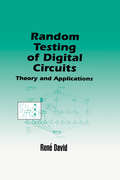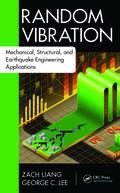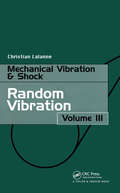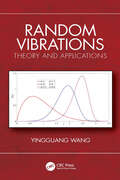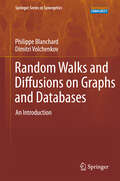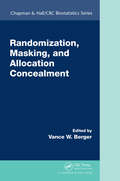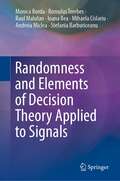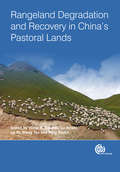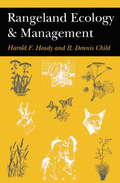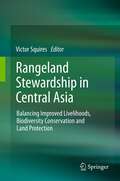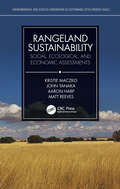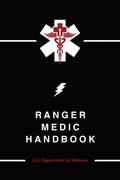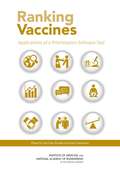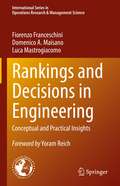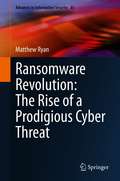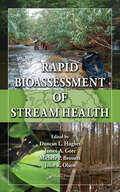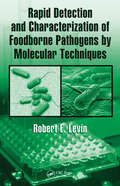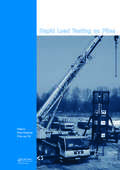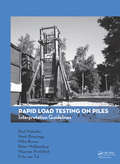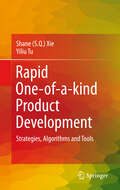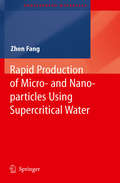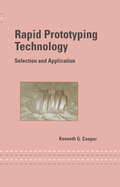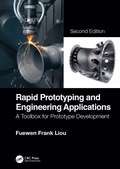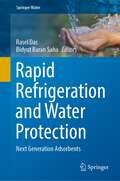- Table View
- List View
Random Testing of Digital Circuits: Theory and Applications
by Rene David"Introduces a theory of random testing in digital circuits for the first time and offers practical guidance for the implementation of random pattern generators, signature analyzers design for random testability, and testing results. Contains several new and unpublished results. "
Random Vibration: Mechanical, Structural, and Earthquake Engineering Applications (Advances in Earthquake Engineering)
by Zach Liang George C. LeeFocuses on the Basic Methodologies Needed to Handle Random ProcessesAfter determining that most textbooks on random vibrations are mathematically intensive and often too difficult for students to fully digest in a single course, the authors of Random Vibration: Mechanical, Structural, and Earthquake Engineering Applications decided to revise the cu
Random Vibration: Random Vibration (Iste Ser. #Volume 3)
by Christi LalanneThe vast majority of vibrations Encountered in the real Environment are random in nature. Such vibrations are intrinsically complicated, and this volume describes the Enabling process for simplification of the analysis required. and the analysis of the signal in the frequency domain. Power spectrum density is also defined, with the requisite precautions to be taken in its calculation described together with the processes (windowing. overlapping) necessary for improved results. A further complementary method, the analysis of statistical properties of the time signal. is described. This enables the distribution law of the maxima of a random Gaussian signal to be determined and simplifies calculation of fatigue damage to be made by the avoidance of the direct counting of peaks.
Random Vibrations: Theory and Applications
by Yingguang WangRandom Vibrations: Theory and Applications investigates methods and theories involved in random vibration analyses of linear and nonlinear systems, as well as in predicting random vibration induced failures.This book is a lucid and well-paced introduction to random vibrations, superbly motivated and illustrated through a wealth of convincing applications in various engineering fields. The strong points of the book are its coverage of weakly stationary and ergodic random processes, spectral analysis of random processes, mode displacement superposition method, equivalent linearization technique for nonlinear random vibrations and an updated definition of rain flow cycle for fatigue analysis. Particularly appealing features of the book are its numerous examples and end-of-chapter exercises. This book offers a clear guide to the formulations and mathematical properties of random vibration analysis techniques, with an emphasis on practical applications rather than mathematical development for its own sake. However, some important mathematical formulas have been explicitly deduced in a detailed manner so that readers can go through the material in this book very smoothly and efficiently.This book is intended for upper undergraduate and graduate students who are interested in learning advanced techniques for performing random vibration analysis, researchers and scientists investigating linear and nonlinear systems under random external excitations, and aeronautical/civil/mechanical/structural/ocean engineers involved in the design and manufacture of real-world stochastically excited engineering systems.
Random Walks and Diffusions on Graphs and Databases
by Dimitri Volchenkov Philipp BlanchardMost networks and databases that humans have to deal with contain large, albeit finite number of units. Their structure, for maintaining functional consistency of the components, is essentially not random and calls for a precise quantitative description of relations between nodes (or data units) and all network components. This book is an introduction, for both graduate students and newcomers to the field, to the theory of graphs and random walks on such graphs. The methods based on random walks and diffusions for exploring the structure of finite connected graphs and databases are reviewed (Markov chain analysis). This provides the necessary basis for consistently discussing a number of applications such diverse as electric resistance networks, estimation of land prices, urban planning, linguistic databases, music, and gene expression regulatory networks.
Randomization, Masking, and Allocation Concealment (Chapman & Hall/CRC Biostatistics Series)
by Vance BergerRandomization, Masking, and Allocation Concealment is indispensable for any trial researcher who wants to use state of the art randomization methods, and also wants to be able to describe these methods correctly. <P><P>Far too often the subtle nuances that distinguish proper randomization from flawed randomization are completely ignored in trial reports that state only that randomization was used, with no additional information. Experience has shown that in many cases, the type of randomization that was used was flawed. It is only a matter of time before medical journals and regulatory agencies come to realize that we can no longer rely on (or publish) flawed trials, and that flawed randomization in and of itself disqualifies a trial from being robust or high quality, even if that trial is of high quality otherwise. <P><P>This book will help to clarify the role randomization plays in ensuring internal validity, and in drawing valid inferences from the data. The various chapters cover a variety of randomization methods, and are not limited to the most common (and most flawed) ones. Readers will come away with a profound understanding of what constitutes a valid randomization procedure, so that they can distinguish the valid from the flawed among not only existing methods but also methods yet to be developed.
Randomness and Elements of Decision Theory Applied to Signals
by Monica Borda Romulus Terebes Raul Malutan Ioana Ilea Mihaela Cislariu Andreia Miclea Stefania BarburiceanuThis book offers an overview on the main modern important topics in random variables, random processes, and decision theory for solving real-world problems. After an introduction to concepts of statistics and signals, the book introduces many essential applications to signal processing like denoising, texture classification, histogram equalization, deep learning, or feature extraction. The book uses MATLAB algorithms to demonstrate the implementation of the theory to real systems. This makes the contents of the book relevant to students and professionals who need a quick introduction but practical introduction how to deal with random signals and processes
Rangeland Degradation and Recovery in China's Pastoral Lands
by Yang Youlin Wang Tao Lu Xinshi Lu Qi Victor R. SquiresThe extreme climate variability that characterizes China's arid rangelands can cause drought and degradation, resulting in dust storms, floods, animal losses, financial hardship and a decline in food availability. Addressing the issues of even greater climate extremes in the future, this book discusses both new approaches and past successes and failures in order to provide the necessary insight to develop sustainable rangeland management strategies, drawing on regional case studies and lessons learned from Australia, Canada and the USA.
Rangeland Ecology And Management
by Harold Heady R. Dennis ChildOver the last two decades the science of range management, like many other resource disciplines, has embraced and integrated environmental concerns in the field, the laboratory, and policy. Rangeland Ecology and Management now brings this integrated approach to the classroom in a thoroughly researched, comprehensive, and readable text. The authors discuss the basics of rangeland management--including grazing and practical management of animals and vegetation--and place those basics within the context of decision making for damaged land, riparian and water conservation, multiple use, and modeling. Concepts such as succession, stability, and range condition are examined and their effects discussed. Fire is considered as an environmental factor. Appendixes provide scientific and common names of range plants and animals. These and many other issues crucial to the understanding of successful range management combine to make the finest text for upper-level undergraduates now available.
Rangeland Stewardship in Central Asia
by Victor R. SquiresThis volume of 18 chapters is the work of more than 30 authors, many of whom are natives of the Central Asian region or are researchers who have dedicated a large part of their working lives to studying the development dynamics in this vast and fascinating region. The work focuses on the 20 years since the collapse of the Soviet Union in 1990. But it also traces the attitudes of land users to the land dating from before the late 19th century, when Russian conquest and colonization occurred, and through the upheavals caused by Soviet-style collectivization and sedentarization. The book is rich with new data presented in 68 easy to understand charts/graphs (many in color) and 50 Tables. Information was generated for this book by experts working in-country. It presents for the first time in English a digest of plethora of previously inaccessible Russian reports and scientific literature that will be invaluable for development agencies, including UN, World Bank, Asian Development Bank, Islamic Bank as well as to students of this vast and fascinating region who seek up to date and authoritive information.
Rangeland Sustainability: Social, Ecological, and Economic Assessments (Environmental and Societal Dimensions of Sustainable Development Goals)
by Kristie Maczko Aaron Harp John Tanaka Matt ReevesThis book provides an integrated description of the indicators of rangeland sustainability that capture ecological, economic, and social dimensions. It takes a fresh look at the information available on current and emerging issues across rangelands, and presents collaborative research for future progress. Authors offer a framework for evaluating rangeland sustainability, the best available data to use, as well as an interactive tool for use at a variety of geographical scales. Readers with limited knowledge of rangelands, as well as professional rangeland ecologists and land managers, will gain an understanding of the best tools available today to assess sustainability across rangeland ecosystems in the U.S.
Ranger Medic Handbook
by U.S. Department of DefenseHistorically in warfare, the majority of all combat deaths have occurred prior to a casualty ever receiving advanced trauma management. The execution of the Ranger mission profile in the Global War on Terrorism and our legacy tasks undoubtedly will increase the number of lethal wounds. Ranger leaders can significantly reduce the number of Rangers who die of wounds sustained in combat by simply targeting optimal medical capability in close proximity to the point of wounding. Directing casualty response management and evacuation is a Ranger leader task; ensuring technical medical competence is a Ranger Medic task. A solid foundation has been built for Ranger leaders and medics to be successful in managing casualties in a combat environment. The true success of the Ranger Medical Team will be defined by its ability to complete the mission and greatly reduce preventable combat death. Rangers value honor and reputation more than their lives, and as such will attempt to lay down their own lives in defense of their comrades. The Ranger Medic will do no less.
Rani Choudhury Must Die
by Adiba JaigirdarIn this sapphic dual POV romance by Adiba Jaigirdar, Meghna and Rani (ex-best-friends-turned-rivals) realize they're dating the same guy, so they team up to beat and expose him at a big science competition! Meghna Rahman is tired of constantly being compared to her infuriatingly perfect ex best friend now rival. Everyone, except, at least, her boyfriend Zak, seems to think that Rani Choudhury can do no wrong—even her own parents! It doesn’t help that Rani is always accepted into the Young Scientist Exhibition, while Meghna’s projects never make it. But this year, she finally has a chance at defeating Rani in something.Rani Choudhury is tired of feeling like she doesn’t have much say in her life—not when it comes to how her mom wants her to look and act or how her parents encourage her to date incredibly charming close family friend Zak. She would much rather focus on her coding, especially once she places high enough at the Young Scientist Exhibition to go on to the European Young Scientist ExhibitionWhen Meghna and Rani figure out that Zak has been playing them both, they decide to do something no one would see coming: they team up. They’ll compete in the EYSE as partners, creating an app that exposes cheaters and a project that exposes Zak. But with years of silence and pressure between them, working together will prove difficult. Especially once each girl starts to realize that the feelings they had for the other may have been more than platonic...Hey, no one ever said science was easy!
Ranking Vaccines: Use Case Studies and Data Framework
by Guruprasad MadhavanSMART Vaccines - Strategic Multi-Attribute Ranking Tool for Vaccines - is a prioritization software tool developed by the Institute of Medicine that utilizes decision science and modeling to help inform choices among candidates for new vaccine development. A blueprint for this computer-based guide was presented in the 2012 report "Ranking Vaccines: A Prioritization Framework: Phase I. " The 2013 "Phase II" report refined a beta version of the model developed in the Phase I report. "Ranking Vaccines: Applications of a Prioritization Software Tool: Phase III: Use Case Studies and Data Framework" extends this project by demonstrating the practical applications of SMART Vaccines through use case scenarios in partnership with the Public Health Agency of Canada, New York State Department of Health, and the Serum Institute of India. This report also explores a novel application of SMART Vaccines in determining new vaccine product profiles, and offers practical strategies for data synthesis and estimation to encourage the broader use of the software.
Rankings and Decisions in Engineering: Conceptual and Practical Insights (International Series in Operations Research & Management Science #319)
by Fiorenzo Franceschini Luca Mastrogiacomo Domenico A. MaisanoThis book focuses on decision-making problems in engineering. It investigates the ranking aggregation problem and the related features, such as input/output data, simplification hypotheses, importance hierarchy of experts. In addition to a well-structured overview of several interesting, consolidated methodological approaches, it presents innovative approaches that can also be applied profitably in other fields. The fascinating selection of topics included is based on research that has been developed in the past twenty years. The descriptions are supported by figures, tables, flowcharts, diagrams, examples and practical case studies. The book is an ideal resource for engineering academics, practitioners, technicians and students, who do not necessarily have an in-depth knowledge of decision-making. It is also a thought-provoking read for engineers and academics looking for innovative ways to improve engineering processes in a variety of fields, such as conceptual design, quality improvement, reliability engineering. “Today, rankings are exercised in all spheres of life, products are ranked on Amazon and similar platforms; services such as restaurants and hotels on platforms such as TripAdvisor; and other services such as lectures or even medical treatment on different specialized platforms. We often make our daily decisions based on these rankings. The quality of our decisions depends on our ability to select appropriate methods to fit the context and needs. We need to be familiar with the theory and practice of these methods to make them useful. To this purpose, this book is an important addition to the bookshelves of academics and professionals, not only from engineering. The connection between theory and practice is weaved throughout the book, making it useful for practitioners also.” Prof. Yoram Reich, Full Professor and Head of Systems Engineering research Initiative at Tel Aviv University (Israel), Editor-in-Chief of “Research in Engineering Design”
Ransomware Revolution: The Rise of a Prodigious Cyber Threat (Advances in Information Security #85)
by Matthew RyanThis book explores the genesis of ransomware and how the parallel emergence of encryption technologies has elevated ransomware to become the most prodigious cyber threat that enterprises are confronting. It also investigates the driving forces behind what has been dubbed the ‘ransomware revolution’ after a series of major attacks beginning in 2013, and how the advent of cryptocurrencies provided the catalyst for the development and increased profitability of ransomware, sparking a phenomenal rise in the number and complexity of ransomware attacks. This book analyzes why the speed of technology adoption has been a fundamental factor in the continued success of financially motivated cybercrime, and how the ease of public access to advanced encryption techniques has allowed malicious actors to continue to operate with increased anonymity across the internet. This anonymity has enabled increased collaboration between attackers, which has aided the development of new ransomware attacks, and led to an increasing level of technical complexity in ransomware attacks. This book highlights that the continuous expansion and early adoption of emerging technologies may be beyond the capacity of conventional risk managers and risk management frameworks.Researchers and advanced level students studying or working in computer science, business or criminology will find this book useful as a reference or secondary text. Professionals working in cybersecurity, cryptography, information technology, financial crime (and other related topics) will also welcome this book as a reference.
Rapid Bioassessment of Stream Health
by John R. Olson Duncan L. Hughes James Gore Michele P. BrossettTasked by the Clean Water Act to restore and maintain the integrity of their waters, state and local governments must develop systems for assessing the health of the streams within their borders. They quickly find that one size does not fit all when it comes to sampling. Rapid Bioassessment of Stream Health examines the sampling techniques, laborat
Rapid Detection and Characterization of Foodborne Pathogens by Molecular Techniques
by Robert E. LevinWritten by one of the most prolific and respected researchers in food safety, this volume describes molecular techniques for the detection and discrimination of major infectious bacteria associated with foods. Each chapter deals with a specific organism and techniques applied to that organism. Particular focus is placed on genes associated with pathogenicity used in the polymerase chain reaction (PCR) including real-time PCR for specific detection of pathogenic bacteria and the inherent limitations of such methodology with certain pathogens. Methods for extracting microorganisms from complex food matrices andDNA purification techniques are also emphasized.
Rapid Load Testing on Piles
by Paul Hölscher Frits Van TolTo obtain data about the stiffness and bearing capacity of a foundation pile, the Rapid Load Test could be an effective and economic alternative for a static load test. In order to judge this, the influence of rate effects in clay and pore water pressures in sand should first be understood. This book presents the latest developments in the research
Rapid Load Testing on Piles: Interpretation Guidelines
by Paul Holscher Henk Brassinga Michael Brown Peter Middendorp Maarten Profittlich Frits A. van TolA Rapid Load Test (RLT), developed to determine the initial stiffness and bearing capacity, is an economical and practical alternative to a Static Load Test (SLT). The broad application of RLT, however, was hampered by uncertainty about the interpretation of the test results. This book offers clear guidance on the available analysis techniques and
Rapid One-of-a-kind Product Development
by Shane Shengquan Xie Yiliu TuRapid One-of-a-kind Product Development discusses research in the development of new enabling technologies for small and medium companies. Scientific advancements presented include a novel product data modelling scheme to model product design, manufacturability and knowledge under a common data object; customised product development in a distributed environment; and new adaptive scheduling methods for the optimal production of a wide variety of customised products, taking into consideration all of the possible changes from customers and the uncertainties in manufacturing. The book also includes research towards a computer aided customer interface, which allows customer requirements and changes to be processed and integrated with technical designs in real time; adaptive and concurrent CAD methods and algorithms; and product modelling and system integration technologies. The reader will learn how to: * translate customer requirements to technical attributes; * develop new and innovative products to meet customer requirements and expectations; * evaluate and optimise a project design; * design production systems and use them efficiently; and * manage a variety of customised products. Rapid One-of-a-kind Product Development demonstrates how to develop new methods, tools and algorithms to address the problems in a mass customisation environment. It is a valuable source of information for researchers and engineers in the fields of design and manufacturing.
Rapid Production of Micro- and Nano-particles Using Supercritical Water
by Zhen FangThis book shows how to use supercritical water (SCW) to synthesize nano- and micro- oxides, inorganic salts and metal particles and its recent advancement. Also polymer/biomass particles can be produced by using the method of precipitation of solutes from SCW. The particles can be used as catalysts for biomass conversions, materials in ceramics & electronic devices and composite materials. Particles are easily produced continuously in a flow reactor in short and long reaction times. Besides the synthesis process, the book also present studies of the properties of these materials. The size, size distribution, crystal growth & structure, and morphology of particles produced by supercritical water can be controlled by the feed concentrations, pH, pressures, temperatures, heating & cooling rates, organic modifications, reducing or oxidizing atmospheres, flow rates and reaction times.
Rapid Prototyping Technology: Selection and Application
by Kenneth CooperReviews operation principles and methods for most Solid Freeform technologies and historical systems data. Illustrates the uses and mechanical details for a number of systems, including JP-System 5, Ballistic Particle Manufacturing, Fused Deposition Modeling, Laminated Object Manufacturing, Stereolithography, and Selective Laser Sintering.
Rapid Prototyping and Engineering Applications: A Toolbox for Prototype Development, Second Edition
by Fuewen LiouSince the publication of the first edition, several Additive Manufacturing technologies have been invented, and many new terminologies have been formalized. Each chapter has been brought up-to-date so that this book continues with its coverage of engineering procedures and the application of modern prototyping technologies, such as Additive Manufacturing (AM) and Virtual Prototyping (VP) that quickly develops new products with lower costs and higher quality. The examples, practice exercises, and case studies have also been updated. <P><P>Features <li>Gears toward rapid product prototyping technologies <li>Presents a wide spectrum of prototyping tools and state-of-the-art additive manufacturing technologies <li>Explains how to use these rapid product prototyping tools in the development of products <li>Includes examples and case studies from the industry <li>Provides exercises in each chapter along with solutions
Rapid Refrigeration and Water Protection: Next Generation Adsorbents (Springer Water)
by Rasel Das Bidyut Baran SahaThis book provides a cross-disciplinary, multi-scale assessment of the development of adsorption-based refrigerants and super-adsorbent-based wastewater purification. The book covers two major aspects from the 21st century, including the development of an environmentally benign adsorption cooling system and the preparation of a super-adsorbent for water purification. Although work has been published on these topics, the authors present the latest findings and introduce some new perspectives. The book is written as a reference book with contributions from global field experts and will appeal to water engineers, chemists, environmentalists, physicists, material scientists, nano-technologists, and environmental technologists.
